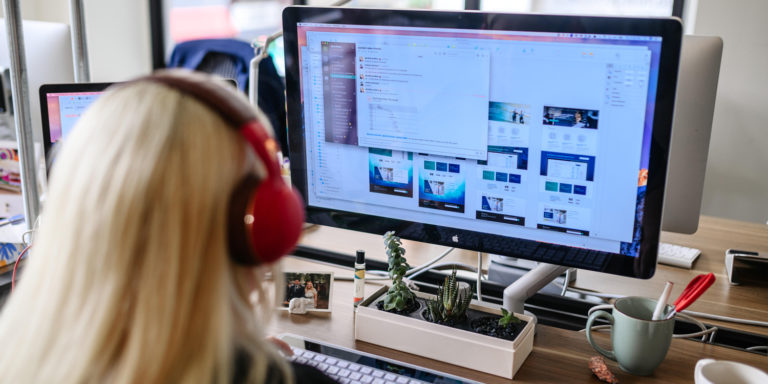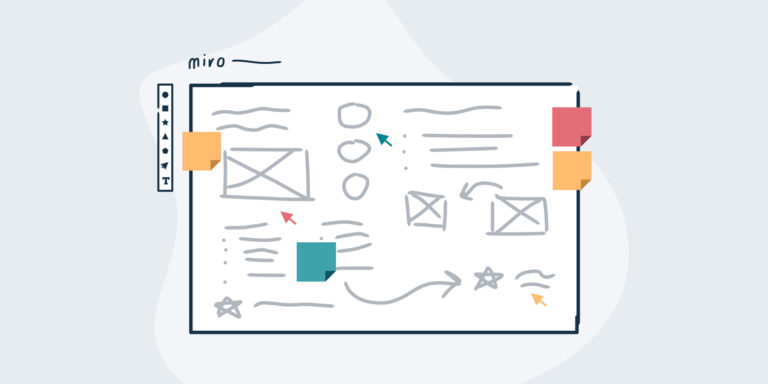How we ran a successful 8-hour remote client working session

Last week, we held a completely remote, all-day working session with a client team—9 of us total who dialed in from several locations across the U.S. The original plan was for a group of us Thinkers to travel to our client’s office in Vermont to do the session in person, the way we often run Think Sessions, workshops, and wrap-up meetings. Of course, due to recent concerns around COVID-19, travel, and social distancing, we needed to adjust quickly and find a way to make it all work remotely.
Because of the group’s hard work, planning, and facilitation skills, we had—dare I say—a fun and productive day! In an effort to share what we’ve learned through this process, here are the steps we took to make this session a success, including the preparation, adjustments, success indicators, tools, and surprises involved.
Preparing the Team
Before we dive in, it’s worth noting that Think Company is already set up to a degree for remote work across our studios and with clients, so this transition hasn’t been too disruptive on our end. With this head start, we were able to focus on making the whole process easy and efficient.
As we sat down to plan the session, we thought about how the structure of the day may need to change to accommodate the lack of in-person interaction for 8 full hours. To our surprise, we realized that not too much needed to change at all. We created the day’s agenda and presentation deck like we normally would, and focused on preparing for an environment where we knew participants may be feeling distracted, busy, or concerned about productivity.
One useful step was to design the day for small working sessions, then send out an agenda with details about who needed to be involved for which parts of the session. This was important, because we were all adjusting to a rapid change in our working standards, and with that had come some uncertainty about how to make the most of our collective time. (Normally, we’d have everyone in a room to tackle the whole day together, knowing that folks would duck out as needed.) This chunked-out schedule gave everyone a sense of relief and focus.
It also felt important to address concerns about the change in approach ahead of time. We held a check-in and planning session with the client team a day before—which allowed us to answer questions and make adjustments—and the client handled all the logistics of scheduling the right people on their end.
Here are some of the key preparation points we’d recommend:
- Establish some etiquette around taking breaks during remote sessions—especially long ones. Small actions like leaving the room to take an urgent phone call, get a glass of water or coffee, or use the restroom can feel more natural during in-person events, but can feel rude during a video call. With clear guidelines and expectations, people feel more relaxed, less self-conscious, and more willing to jump into discussion.
- To that point, encourage everyone to prepare to use their camera for video rather than a still image, or nothing at all. I’ll go into the specific reasons why this was important, but this effort makes a big difference in the group’s engagement.
- Send everyone involved a set of well-organized calendar invitations with easy-to-access dial-in information. This is a key part of alleviating time-consuming logistical friction.
Running the Session
Since we knew ahead of time who was needed during specific parts of the agenda—and more importantly, who wasn’t needed—jumping into the agenda felt immediately efficient.
We made sure to take short breaks after major discussion topics, the same way we would during an in-person session. When you’re running a meeting in person, you can see people’s faces and decide quickly when it’s time to break. This is a little harder to do virtually, and it’s one of the biggest benefits of encouraging participants to keep their cameras running. Without these social cues, it can be difficult to read the room and make sure everyone is with you.
We set a time limit for each break and told participants exactly when to report back. This was true for shorter, 10-minute breaks as well as our longer, 1-hour lunch break. Everyone turned off their video and muted their microphones to take much-needed time away from their screens, and we turned both back on to let everyone know we were ready to rejoin the group (which started a fun game of who will be the first to turn their video back on?). This system allowed some folks to return early for social interaction—yet another argument for using video, and an important element of in-person sessions we wanted to preserve.
Here are a few in-the-moment wins that contributed to high levels of engagement and productivity within our group:
- Use the annotation tools within your video conferencing tool—Zoom in our case. Our client’s team was great at proactively using annotation to call attention to something shared on the screen, or to sketch out a quick idea to help facilitate a conversation.
- Use the chat feature! We made great use of the Zoom chat window to share links that were being discussed, inspiration, and tools that came in handy. After each session wrapped, we were able to record all of that discussion for later reference.
- To address any needs we had for ideation and sketching, we jumped into some of our favorite apps and tools, like Airtable, Sketch, and Abstract for final screenshare walkthroughs. But sharing our screens intermittently through Zoom was enough to get us through the agenda.
Adapting for Next Time
Planning and adjustment efforts aside, did we achieve our goals? Since this was a wrap-up session, we were focused on 1) tying up all loose ends, and 2) helping our clients feel like they had what they needed to move forward. Our clients left with alignment about future meetings, long-term goals, and the tooling knowledge they needed to keep pushing the work beyond our engagement, so we all knew we had succeeded.
After taking stock of our wins and challenges throughout the day, here are some small but meaningful ways you can make this kind of experience even better:
- If you’re a speaker or presenter, use a headset with a microphone if you have one. The sound quality will be better for everyone, which is one of the most important dependencies of remote sessions. You won’t notice the effects of poor sound quality on overall focus until you’re already in the middle of a meeting.
- Address people directly to help facilitate participation. On video calls, it can be more difficult to jump into a conversation since, again, social cues are more subtle.
- Conversely, if folks are hesitating to talk over each other, but you need many people to react at once, consider using hand signals to vote, agree/disagree, etc.
- Consider designating people for added roles in remote environments, like MC, note taker, and tool facilitator. Managing the extra technology details should be a team effort so that one person isn’t too burdened.
As we’re adapting to more and more full or partially-remote working sessions like this one, we have an unlimited number of tools and strategies to employ and experiment with. Designing an environment that’s appropriate for your team, goals, and circumstances is just as important. Keep an eye out for additional resources from us as we document and share what we’re learning during this process.



